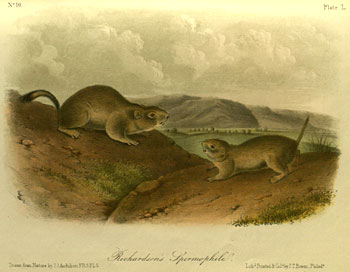
Richardson's Ground Squirrel, Audobon Plate L No. 10While most pioneer gardens produced a few summer vegetables, the important vegetables were root crops that could survive an early frost and could be stored for the winter in root cellars. Canning in glass jars was apparently not widely practiced in territorial Dakota. Few people had expensive tin canning machines, though Mabel Weinberger of Hettinger County had a such canning machine (perhaps after the pioneer era, probably in the 1920s or 1930s). She purchased cans with lids in quantities of 100 from Montgomery Ward. The process was relatively simple: put food in the can, apply the lid. The machine sealed the can. The closed can was then processed in pressure cooker. (Courtin’, p. 83)
Because of the importance of garden crops to the families’ survival, garden pests had to be disposed of. Minnie Ness’s parents had both gophers and rats in garden. Rats were given mush with plaster of Paris mixed into it. After the rats ate the mush, they would drink, and the plaster would harden and kill them. The children killed gophers and turned in the tails for the bounty. They kept cats to kill mice. (Minnie Ness, Burke County, Courtin’, p. 79)
Potato bugs were the other serious garden pests (no one mentions rabbits or deer). As a child, Ruth Stromberg made brushes from fox tail seed heads. These she dipped in Paris Green and brushed on potato plants to kill the bugs. (Ruth Stromberg, Courtin, p. 82.




